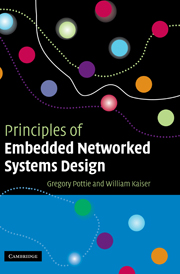Book contents
- Frontmatter
- Contents
- Preface
- Acknowledgments
- List of Abbreviations
- 1 Embedded network systems
- 2 Representation of signals
- 3 Signal propagation
- 4 Sensor principles
- 5 Source detection and identification
- 6 Digital communications
- 7 Multiple source estimation and multiple access communications
- 8 Networking
- 9 Network position and synchronization services
- 10 Energy management
- 11 Data management
- 12 Articulation, mobility, and infrastructure
- 13 Node architecture
- 14 Network data integrity
- 15 Experimental systems design
- 16 Ethical, legal, and social implications of ENS
- 17 Design principles for ENS
- Appendix A Gaussian Q function
- Appendix B Optimization
- Index
10 - Energy management
Published online by Cambridge University Press: 10 August 2009
- Frontmatter
- Contents
- Preface
- Acknowledgments
- List of Abbreviations
- 1 Embedded network systems
- 2 Representation of signals
- 3 Signal propagation
- 4 Sensor principles
- 5 Source detection and identification
- 6 Digital communications
- 7 Multiple source estimation and multiple access communications
- 8 Networking
- 9 Network position and synchronization services
- 10 Energy management
- 11 Data management
- 12 Articulation, mobility, and infrastructure
- 13 Node architecture
- 14 Network data integrity
- 15 Experimental systems design
- 16 Ethical, legal, and social implications of ENS
- 17 Design principles for ENS
- Appendix A Gaussian Q function
- Appendix B Optimization
- Index
Summary
The paramount logistical issues in the deployment of sensor networks over extended time periods are the establishment of reliable communication networks and the provision of energy to operate the system. This chapter is concerned with energy issues: sources, energy consumption for particular operations, and strategies for maximizing the network usefulness subject to energy resource constraints. Without careful attention to energy issues at the levels of both nodes and networks, deployment scales and lifetimes can be sharply limited. In battery-powered devices, each bit communicated or processed brings a node closer to its death. In other situations the power supply may be limited, motivating the choice of lower-energy means of accomplishing the network objectives.
Energy sources
Many different types of energy source are available to networks of embedded devices. Table 10.1 lists some of the possibilities, and their electrical power generation potential. Table 10.2 compares available electrical energy per unit mass of batteries with the chemical energy of various fuels.
These tables show that batteries are quite good power supplies: the power density they can supply is within a factor of 1000 that of nuclear reactions and within a factor of 3–10 of fuel cells depending on the technology. Moreover, while methanol's energy density is 30 times that of the best batteries, clearly energy conversion efficiencies considerably lower the gap particularly if low-temperature operation is required and the weight or volume of an energy conversion device is considered.
- Type
- Chapter
- Information
- Principles of Embedded Networked Systems Design , pp. 309 - 330Publisher: Cambridge University PressPrint publication year: 2005



